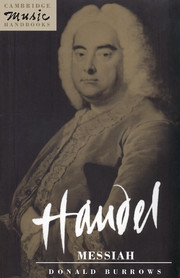Book contents
- Frontmatter
- Contents
- Preface
- References to ‘Messiah’ editions
- 1 The historical background
- 2 From composition to first performance
- 3 The first London performances
- 4 Revival and revision, 1743–1759
- 5 Messiah in other hands
- 6 Design
- 7 Individual movements
- 8 Handel's word-setting
- Appendix 1 The libretto of Messiah
- Appendix 2 Messiah sources
- Notes
- Bibliography
- Index
2 - From composition to first performance
Published online by Cambridge University Press: 05 June 2012
- Frontmatter
- Contents
- Preface
- References to ‘Messiah’ editions
- 1 The historical background
- 2 From composition to first performance
- 3 The first London performances
- 4 Revival and revision, 1743–1759
- 5 Messiah in other hands
- 6 Design
- 7 Individual movements
- 8 Handel's word-setting
- Appendix 1 The libretto of Messiah
- Appendix 2 Messiah sources
- Notes
- Bibliography
- Index
Summary
The composition of Messiah took place in a little over three weeks during the summer of 1741. As it came to take its place as one of the ‘classic’ works within the musical culture of English-speaking communities, the shortness of this composition period was sometimes interpreted as a sign of specific religious inspiration. Handel certainly wrote Messiah in an intense burst of activity: even the physical labour of committing the notes to the pages during that period is remarkable. However, the composition of Messiah was typical of Handel's normal work pattern: most of his operas and oratorios were written with similar concentration between theatrical seasons. After the completion of a series of performances, Handel naturally turned to the repertory needs of the next.
His method of working resembled that of other composers professionally or temperamentally based in the theatre, such as Mozart or Sullivan. With the libretto already arranged into recitatives, arias and (for oratorios) choruses, the first step was to lay out the whole score, composing the arias and choruses in skeleton draft with the leading voices and instrumental parts, and writing in the recitative texts between the arias. The overall scheme was thereby committed to paper, and the musical shape and tonality of the concerted movements (arias, accompanied recitatives, choruses) established. The hard work went into this ‘framing’ stage. Handel completed the ‘filling-up’ of the skeletal outline with composed recitatives and fully-orchestrated movements in two days.
- Type
- Chapter
- Information
- Handel: Messiah , pp. 8 - 22Publisher: Cambridge University PressPrint publication year: 1991

